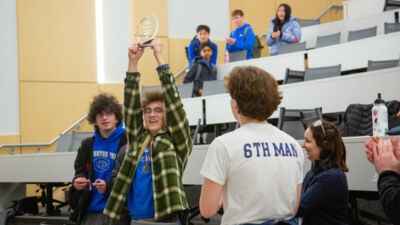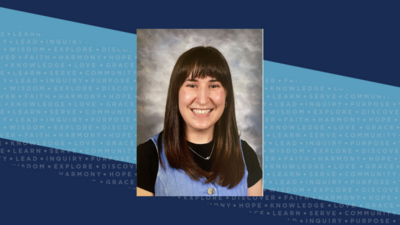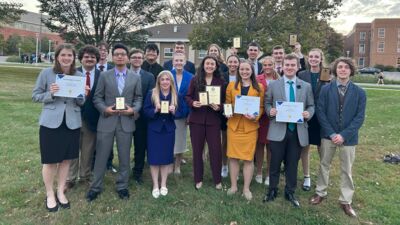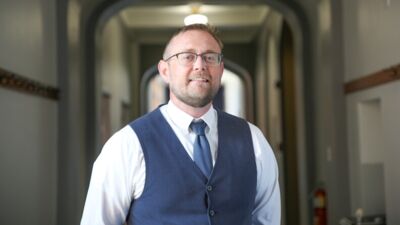Concordia University Nebraska hosts Nebraska Science Bowl middle school and high school events

Concordia Nebraska hosted the Nebraska Science Bowl on Saturday, February 4 for middle school students and on Saturday, February 25 for high school students. The Nebraska Science Bowl is a regional qualifying event for the National Science Bowl, an event that is sponsored by the United States Department of Energy. This is the second year that Concordia Nebraska has hosted the event. Last year, all regional events were virtual, but this year’s events took place in person.
The regional event included participants from schools throughout Nebraska, and the winners received an all-expenses paid trip to Washington D.C. to compete in the national final event April 27 – May 1. The Nebraska Science Bowl is comprised of two competitions – one for middle school and one for high school. At the middle school event, Concordia hosted 26 teams with each team consisting of four or five student competitors and one or two coaches. The high school event included 16 teams.
“The Science Bowl is a great opportunity for the science department to encourage the love of science in the next generation of students,” said Concordia Nebraska professor of physics, Dr. Robert Hermann. “The competitors are incredibly intelligent and motivated. They train and practice for months in advance, and it’s a wonderful thing for the science faculty to get to be a part of their love of science. The Science Bowl is also an opportunity for the science department and the university to show itself to students who either are or will soon be thinking about college. We were able to show Concordia and its science facilities and faculty to over 150 middle school students and teachers and to almost 100 high school students and teachers, plus a large number of families who came along to watch the event. So overall we will probably have almost 300 people on campus, seeing our facilities and our faculty, and seeing Concordia as a top place to do science in Nebraska.”
Nebraska Science Bowl events include morning round robin competitions that are used for seeding an afternoon double elimination tournament. A round of competition consists of two teams of four students answering science questions. The questions are supplied by the national office of the National Science Bowl, and cover the areas of Biology, Chemistry, Physics, Earth and Space, Math, and Energy.
In a competition round, a moderator (usually a faculty member or adult from the community) asks a series of questions “toss up” questions. A toss up question is a multiple choice or short answer question, and students have five seconds to answer. The first student who buzzes in answers the question. If the student gets the question correct, then the moderator reads a bonus question, which the team can collectively discuss and answer in 20 seconds. If the team initially answered the toss up question incorrectly, the other team gets five seconds to answer and an opportunity to answer the bonus. Toss up questions are worth four points and bonus questions are worth 10 points, so there is great incentive to answer the toss up correctly in order to get to the bonus. The questions continue for two eight-minute halves, with a two-minute break between. The team with the most points at the end wins the round.
“The High School Science Bowl went very well,” said Hermann. “We had 16 teams from 11 schools compete – around 75 high school students from around the state from as far away as Cozad, Kearney, and Wayne.”
Moore Middle School in Lincoln and St. John Lutheran School in Seward battled for the middle school event championship, with Moore Middle School Team 1 winning on February 4. Creighton Preparatory School Team 1 and Lincoln East High School Team 2 battled for the high school event championship, with Creighton Preparatory School Team 1 pulling out the win on February 25.
“The process takes a lot of people. In each room during each competition, there’s a moderator reading the questions, a question judge who makes sure the question was read correctly and recognizes the student answering, a time keeper watching for the various time limits, a score keeper who keeps score on the board for everyone to see, and a rules judge who watches everything and makes sure that all the rules are being followed,” explained Hermann. “There are also runners who carry the scoresheets from the competition rooms to a central location where everything is tabulated. That’s five volunteers in each room, plus runners, with as many as 11 rooms going simultaneously. We were very fortunate to have almost 120 students volunteer to help with the competition, and we needed every one. And the students have been fantastic at their various roles. We were thrilled to have almost 60 students help with the event on Saturday, in addition to over 70 who helped for the Middle School event. Our students did a fantastic job – they were professional and engaged, and they represented Concordia tremendously well.”
Hermann said Concordia Nebraska looks forward to hosting the middle school and high school science bowl events again in February 2024.
Interested in learning more about Concordia's science programs? Discover more here.


